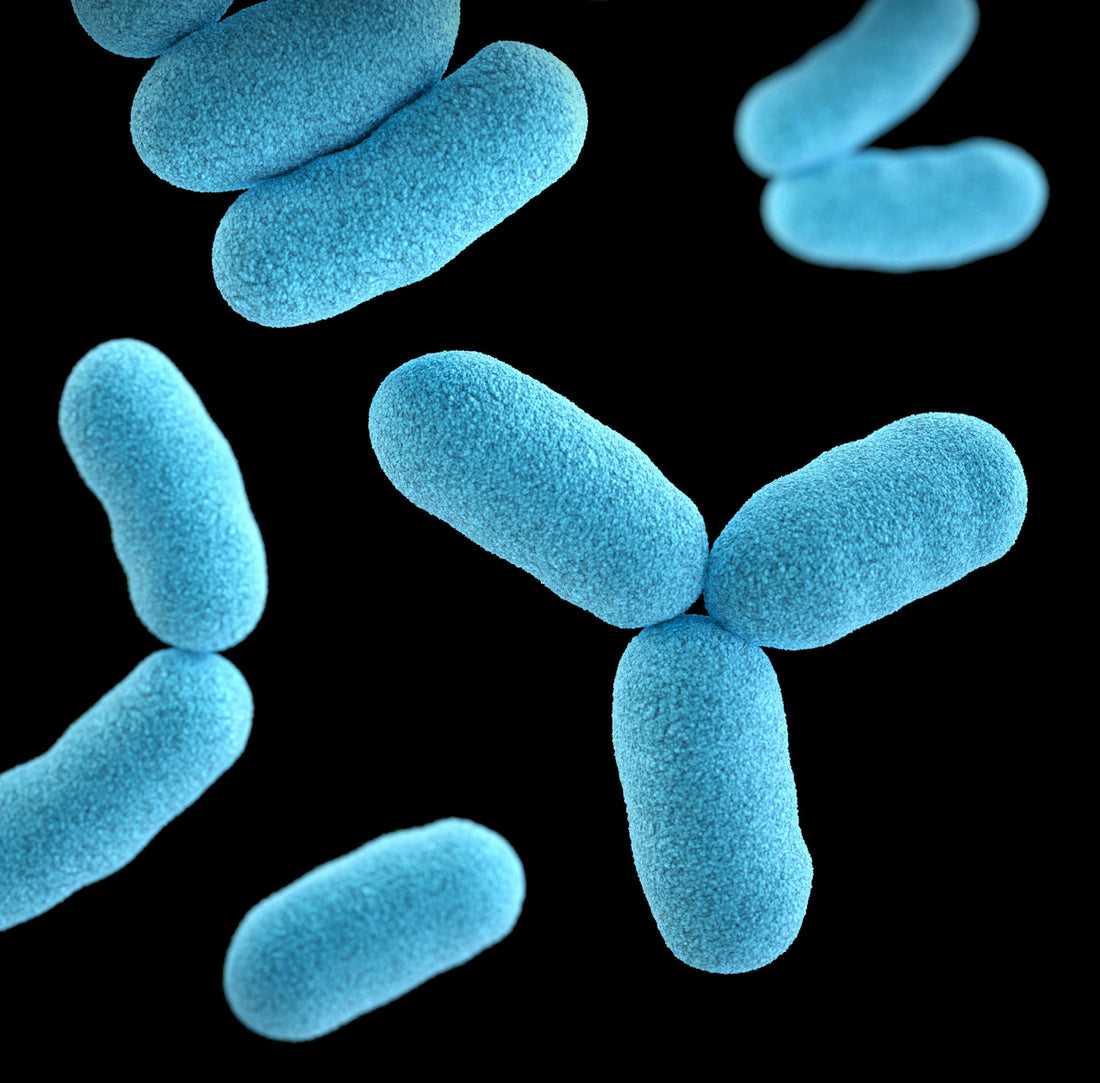

In a world where chronic conditions are on the rise, understanding the intricacies of our body's response to lifestyle and dietary choices has never been more crucial. Metabolic endotoxemia, a condition often lurking behind the scenes of various health issues, poses a significant yet under-recognized threat to our well-being.
Come along as we shed light on the potential causes of endotoxemia and uncover the potential of probiotics as a natural defender against this silent adversary. Let us explore the symbiotic relationship between your health and the microscopic world of probiotics, offering insights and directions for a path toward better health.
What is metabolic endotoxemia and systemic inflammation?
Your body's innate immune system is like a security team always on the lookout for invaders that don’t belong. When certain immune cells, such as macrophages and dendritic cells, detect these invaders (called pathogen-associated molecular patterns or PAMPs) in your blood and tissues, they sound the alarm and kick off an inflammatory response.
One common trigger for this response is lipopolysaccharides (LPS), which are fragments of gram-negative bacterial cells. When LPS gets into your bloodstream, it can cause inflammation not just in a specific area (like a tissue) but throughout your whole body.

Metabolic endotoxemia is a term for a condition where there’s chronic low-grade inflammation because of high levels of LPS in the blood. Normally, short-term inflammation (like when you have an infection) is helpful because it fights off the infection. However, when inflammation is low-grade but constant, it can cause serious damage to organs such as the liver and pancreas due to oxidative stress.
This ongoing, low-level inflammation can lead to metabolic syndrome, which includes a group of health issues like diabetes, non-alcoholic fatty liver disease (NAFLD), obesity, high cholesterol, heart disease, and high blood pressure.
What are the symptoms of metabolic endotoxemia?
Metabolic endotoxemia might manifest itself in different people as persistent fatigue, digestive issues such as bloating, gas, diarrhea, constipation, and general gastrointestinal discomfort. Mental health symptoms such as depression, anxiety, brain fog, and difficulty concentrating, iInflammation resulting in joint pain, muscle aches, and swelling, metabolic symptoms such as weight gain, especially around the abdomen, difficulty losing weight, and insulin resistance, skin concerns such as acne, eczema, and other skin inflammations.
Additional indications include immune system dysfunction including frequent infections, slow recovery from illness, and general immune weakness, cardiovascular symptoms including high blood pressure, elevated cholesterol levels, and increased risk of heart disease, and general malaise such as feeling unwell without a specific cause, general discomfort, and a sense of being unwell.
Metabolic endotoxemia causes
The gut houses billions of microbes belonging to roughly 500 to 1000 different species. Gut bacteria synthesize beneficial metabolites like short chain fatty acids, neurotransmitters like serotonin and dopamine (happy hormones), and shed inflammatory endotoxins like LPS.
When LPS finds its way out of the protective intestinal barrier and into the blood supply, it attaches to receptors present on immune cells, which trigger the innate immune system and lead to systemic low-grade inflammation.
Endotoxemia can be caused by various factors, including diet, gut health, and lifestyle choices. Consuming high-fat (seed oils and margarine) or low-fiber diets, experiencing chronic stress, and having medical conditions like diabetes or inflammatory bowel disease can all contribute to this condition by increasing gut permeability and promoting inflammation.
Additionally, endotoxins can come from external sources, such as contaminated drugs and vaccines, or compounds produced using recombinant E. coli in biotechnology. These endotoxins, if not properly removed during manufacturing, can enter the bloodstream and trigger an immune response, leading to chronic low-grade inflammation.

Intestinal Permeability
The healthy intestinal barrier consists of several protective layers to prevent endotoxins from getting past the gut wall— intestinal alkaline phosphatase (IAP) that neutralizes LPS, inner and outer mucus layers that house beneficial bacteria, and secretory immunoglobulin A (sIgA) to keep gut bacteria from coming in direct contact with intestinal epithelial cells and triggering gut inflammation.
Intestinal epithelial cells are joined together by tight junction proteins that act as the physical glue that holds the gut wall together. Intestinal barrier dysfunction whether due to diet, disease, or stress has been associated with a leaky gut (weak intestinal barrier).
A weak intestinal barrier refers to gaps in the gut wall that allow bacterial endotoxins access to blood vessels and metabolic organs like the liver, pancreas, visceral (belly fat) and subcutaneous adipose tissue (fat tissue under the skin), kidneys, and muscles.
Healthy tight junction proteins selectively become permeable, allowing nutrients and beneficial metabolites to pass through the gut barrier. Triggers such as high blood glucose and western style diets high in vegetable oils and margarine have been associated with alterations in tight junction protein function, developing leaks in the intestinal barrier and allowing microbial toxins to pass through the gut barrier.

What is LPS, and why does it trigger an immune response?
LPS is a molecule found in the outer membrane of Gram-negative bacteria such as eColi. LPS triggers an immune response because it is recognized by the body as an infection. Receptors (TLR-4) present on immune cells and adipose tissue bind to LPS and sound a system wide alarm and call for help.
If you have a weakened intestinal barrier function, LPS, other metabolic endotoxins or partially digested food molecules can end up in the intestinal blood flow and initiate an immune response. The inflammatory response can stay local (gut and liver inflammation) or slowly turn into systemic inflammation.
Impaired intestinal barrier function and low-grade inflammation
A slow but steady trickle of LPS, the most common bacterial endotoxin, through a compromised intestinal barrier, has been linked with a constant state of constant alarm (low-grade inflammation) in the body and the development of disease.
In addition to the intestinal barrier dysfunction pathway, a study published in Nature hypothesizes that since LPS is lipophilic (fat-loving), it gets stored in adipose tissue and attracts innate immune cells like macrophages. Human adipose tissue and immune cells both release inflammatory cytokines (signaling molecules) like tumor necrosis factor (TNF-α) and NF-κB in response to LPS, adding up to a persistent inflammatory response.
High sugar, high fat diet, and LPS
Dysbiosis is a state of imbalance in the gut microbiome when the abundance of beneficial bacteria or the total diversity of the gut microbiome decreases. This imbalance in the abundance of different types of gut bacteria can potentially progress from dysbiosis to disease.
High-sugar (fructose from high fructose corn syrup) and vegetable oils have been associated with metabolic endotoxemia. Consumption of processed foods and diets devoid of dietary fiber have been linked with an increase in LPS-producing gram-negative bacteria like Proteobacteria, dysbiosis and a leaky gut.
Diseases associated with metabolic endotoxemia and low-grade inflammation
A healthy gut plays an essential role in metabolism and detoxification. However, a leaky gut and metabolic endotoxemia may lead to increased oxidative stress, the development of NAFLD, insulin resistance, high blood glucose, and obesity. Diseases that are associated with metabolic endotoxemia and low-grade inflammation are:
- Alzheimer’s Disease
- Parkinson’s Disease
- Rheumatoid Arthritis
- Inflammatory Bowel Disease (IBD)
- Chronic Kidney Disease
- Asthma
- Chronic Obstructive Pulmonary Disease (COPD)
- Depression
- Psoriasis
- Lupus
- Cancer
- Multiple Sclerosis
- Osteoarthritis
- Fibromyalgia
- Polycystic Ovary Syndrome (PCOS)
These diseases are linked to chronic inflammation, which is often exacerbated by metabolic endotoxemia. Managing inflammation through lifestyle changes, diet, and medical treatment can help reduce the risk and impact of these conditions.

Link between inflammatory bowel disease and endotoxemia
IBD is categorized by the damage suffered by the intestinal barrier. The compromised intestinal barrier allows pathogenic gut bacteria and LPS to come in direct contact with intestinal epithelial cells and gut immune cells, triggering gut inflammation, which may develop into inflammatory bowel disease (IBD).
Studies suggest a link between dysbiosis-led changes in the gut microbiota (increase in pathogenic bacteria and reductions in beneficial bacteria) and the development of inflammatory bowel disease. IBD is also linked with an imbalance between gut microbiome directed ant-inflammatory and inflammatory immune cells like Tregs, Th17 and Th1.
LPS, metabolic endotoxemia and Parkinson’s
Parkinson’s disease (PD) is a neurodegenerative movement disorder characterized by the progressive loss of neurons in a brain region called substantia nigra that helps control movement. In addition to motor symptoms, individuals with PD also struggle with non-motor symptoms including GI issues, depression, impaired cognitive function, etc.
Researchers have been looking at different PD models — genetic factors, neurotoxins, and neuroinflammation — to understand how the disease develops and progresses. PD patients tend to have intestinal barrier function and higher serum LPS levels due to H. Pylori and other Gram-negative bacteria in the gut. Studies suggest that LPS severely activates microglia (immune cells present in the brain), which can trigger a pro-inflammatory cascade leading to neuroinflammation and neurodegeneration.
Interestingly, the LPS hypothesis, as a potential trigger for PD, first came up when a lab worker accidentally got exposed to LPS through an open wound and ended up developing PD-like symptoms a few years later.
Probiotics, dysbiosis, and serum LPS
Pathogenic bacteria and endotoxins have been associated with inflammation, likewise, beneficial bacteria or probiotics like Lactobacillus reuteri have been associated with increased antimicrobial activity in the gut, inhibiting the growth of pathogenic bacteria, anti-inflammatory effects and remodeling the native (commensal) microbiome composition.
In a 12-week randomized clinical trial studying the effects of our Sugar Shift™ probiotic formula on health variables like HbA1c, serum LPS concentration, triglycerides, etc. in type 2 diabetes found a significant reduction in plasma LPS concentration.
 Sugar Shift™ consists of a microbial guild with eight strains including Bacillus subtilis De111™, Bifidobacterium bifidum, Bifidobacterium longum, Lactobacillus paracasei, Lactobacillus plantarum TBC0036, Lactobacillus reuteri, Leuconostoc mesenteroides TBC0037 and Pediococcus acidilactici that work cohesively to convert excess glucose and fructose into mannitol, a powerful free radical scavenger and producing butyrate which supports a healthy gut barrier. The clinical study showed enhanced microbiome composition and increased abundance of beneficial bacteria that have a regulatory effect on the immune system.
Sugar Shift™ consists of a microbial guild with eight strains including Bacillus subtilis De111™, Bifidobacterium bifidum, Bifidobacterium longum, Lactobacillus paracasei, Lactobacillus plantarum TBC0036, Lactobacillus reuteri, Leuconostoc mesenteroides TBC0037 and Pediococcus acidilactici that work cohesively to convert excess glucose and fructose into mannitol, a powerful free radical scavenger and producing butyrate which supports a healthy gut barrier. The clinical study showed enhanced microbiome composition and increased abundance of beneficial bacteria that have a regulatory effect on the immune system.
Diet-induced dysbiosis and metabolic endotoxemia can silently wreak havoc on your body for years before it shows up as ill health. The gut microbiome is ground zero for effecting lasting change, and our Sugar Shift™ might be the perfect start towards getting you started on combating metabolic endotoxemia, systemic inflammation and achieving your health goals.
Frequently Asked Questions
What is metabolic endotoxemia? What causes metabolic endotoxemia?
Metabolic endotoxemia refers to low-grade chronic inflammation in response to bacterial endotoxins like lipopolysaccharides (LPS). LPS is a cell wall component of gram-negative bacteria found in the gut microbiome. LPS may enter the blood supply via a compromised intestinal barrier and trigger an inflammatory response in the body.
How many people are affected by metabolic endotoxemia?
Roughly 33% of the Western population is estimated to be impacted by metabolic endotoxemia. Consumption of ultra-processed foods containing high fat and high sugar levels has been associated with the development of a weakened intestinal barrier and the translocation of microbial endotoxin LPS into the blood supply, triggering an inflammatory immune response.
With gratitude,

 Martha Carlin, is a “Citizen Scientist”,
systems thinker, wife of Parkinson’s warrior, John Carlin, and founder of The BioCollective , a microbiome company expanding
the reach of science and BiotiQuest, the first of it’s kind probiotic line. Since John’s diagnosis in 2002,
Martha began learning the science of agriculture, nutrition, environment, infectious disease, Parkinson’s
pathology and much more. In 2014, when the first research was published showing a connection between the gut
bacteria and the two phenotypes of Parkinson’s, Martha quit her former career as a business turnaround expert
and founded The BioCollective to accelerate the discovery of the impact of gut health on all human disease. Martha was a speaker at the White House 2016 Microbiome Initiative launch, challenging the scientific
community to “think in a broader context”. Her systems thinking background and experience has led to collaborations
across the scientific spectrum from neuroscience to engineering to infectious disease. She is a respected out of the
box problem solver in the microbiome field and brings a unique perspective to helping others understand the
connections from the soil to the food to our guts and our brains.
Martha Carlin, is a “Citizen Scientist”,
systems thinker, wife of Parkinson’s warrior, John Carlin, and founder of The BioCollective , a microbiome company expanding
the reach of science and BiotiQuest, the first of it’s kind probiotic line. Since John’s diagnosis in 2002,
Martha began learning the science of agriculture, nutrition, environment, infectious disease, Parkinson’s
pathology and much more. In 2014, when the first research was published showing a connection between the gut
bacteria and the two phenotypes of Parkinson’s, Martha quit her former career as a business turnaround expert
and founded The BioCollective to accelerate the discovery of the impact of gut health on all human disease. Martha was a speaker at the White House 2016 Microbiome Initiative launch, challenging the scientific
community to “think in a broader context”. Her systems thinking background and experience has led to collaborations
across the scientific spectrum from neuroscience to engineering to infectious disease. She is a respected out of the
box problem solver in the microbiome field and brings a unique perspective to helping others understand the
connections from the soil to the food to our guts and our brains.


Waking Up to a Probiotic Breakfast Can Do Wonders for Your Gut Health
Did you know that recent studies show people with poor gut diversity had lower quality of life? The health of your microbiome impacts your mental health, sleep, energy, the risk for chronic illnesses, and much more. A probiotic breakfast can...

Can Probiotic Supplements Make or Break Your Fast?
Intermittent fasting (IF) may have started as a fitness trend for weight loss, but today it's a go-to lifestyle choice for many. Practicing intermittent fasting has been linked with health benefits such as lowering blood sugar and insulin, preventing heart...














 Martha Carlin
Martha Carlin







